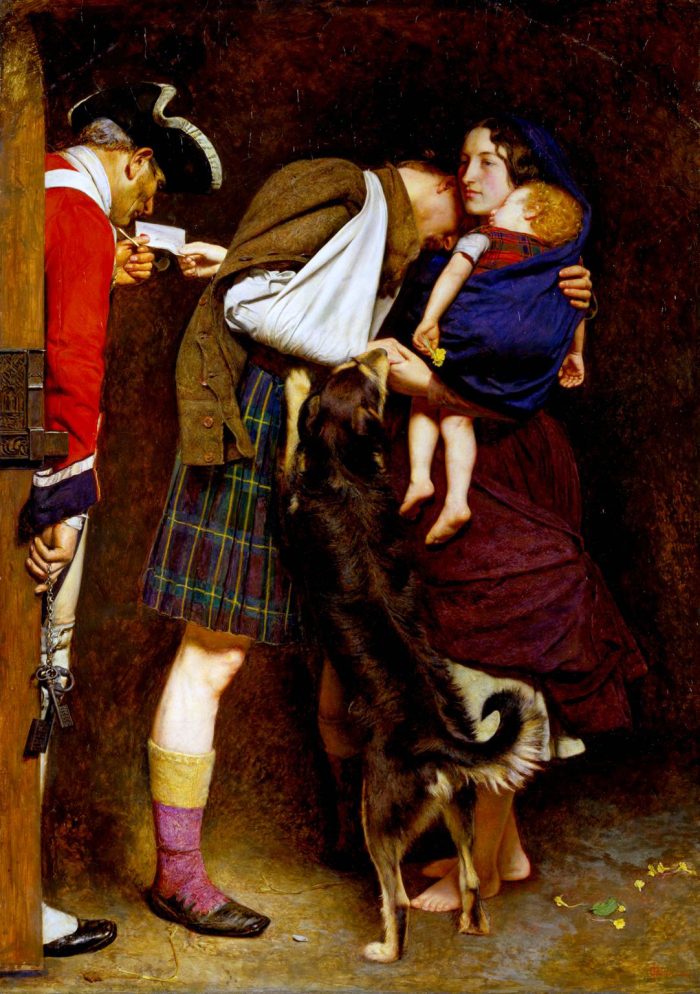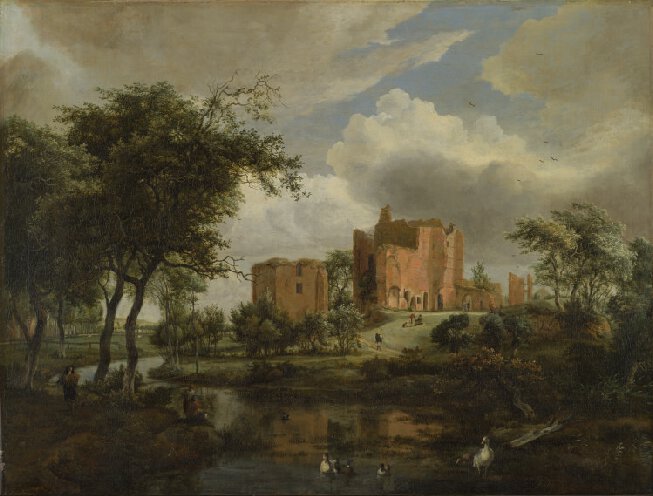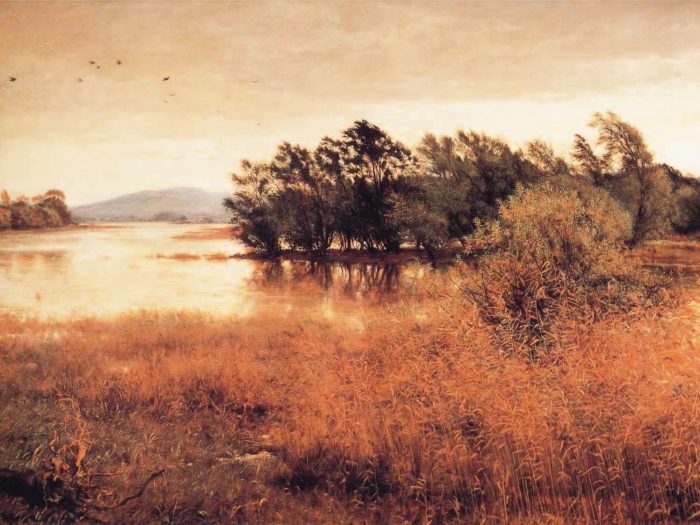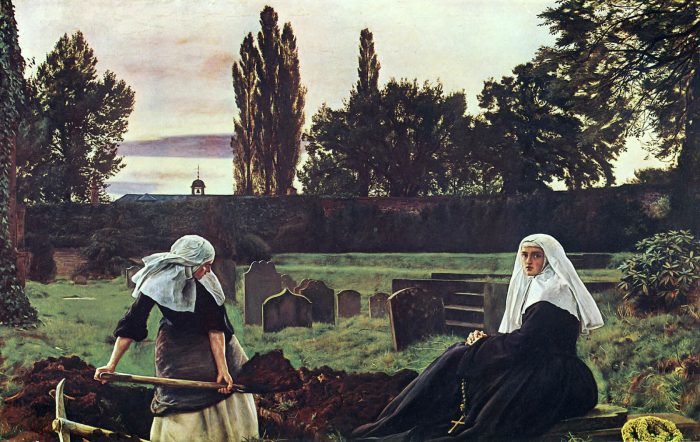Some Notes on Millais As a Painter of Landscape, by H.W.B. Davis, R.A., published in The Life and Letters of Sir John Everett Millais.

You have asked me for my opinion in general of Millais’ power as a landscape painter, as well as for some remarks in particular of his picture of “The Blind Girl,” possibly from having heard me speak on some occasion with enthusiasm of that wonderful little work looked at from a landscape painter’s point of view.
The picture is, indeed, to my mind, a marvel among pictures–even among Millais’, considering at what an early stage in his career it was produced–for, putting aside for the moment the main subject of the picture–its great pathos, its remarkable realistic drawing, and the vigour of painting and colour in the figures–and looking upon the work in the sense of a landscape alone, it is, with its power and brilliancy as such, simply astonishing. A piece of great landscape painting is there, though on a scale so small that the hand might suffice to cover the surface of the whole background, and replete with detail of extraordinary minuteness; one of his few, too, dealing with a transient effect of Nature.
The sun shines out, after the rain, in all its lustre upon the green grass and wet landscape, and brightens the trees, the buildings, and all the details of the background with a vividness, a freshness, and a reality that are amazing.
What an effect its appearance must have had upon the Art world of the day–what a revelation to earnest students of out-door Nature! I recollect its exhibition at the Royal Academy, though too inexperiences at the time to appreciate its dazzling merits. It did have its effect, for I was not so young that I did not perceive its immediate influence–upon landscape painting particularly–in inculcating a more searching study of, a constant reference to, Nature herself for her facts, and a Truer reverence for them, and refusing to be satisfied with the mere superficial cleverness and artificiality too prevalent at the time.

In this connection–I mean of his close study of Nature, and its effect upon contemporaneous landscape Art–I ought to allude to his earlier work, the “Ophelia” (which had already raised much discussion), for the keen observation and uncompromising rendering of Nature’s facts displayed in the picture. The very individual character of his subject–that and no other–this is so remarkable in his portraits and figures, is to be seen here in every bit of foliage, every flower, water-herbs, and weed. Look but at the group of flags, and the liquidity of the water around them–at the weeds emerging from the water in their front, at the shortened twigs and branches of the willow–and remember that these were painted before the time when photography had been essayed upon landscape objects, and had familiarised us with their accurate delineation.
Had such facts ever been so observed and so rendered before?
In these two works of Millais, as, indeed, in all his subsequent landscapes, they are as much pieces of characteristic portraiture as are the subjects he has painted from living models. They were painted, too, with an evident ease; there is no sign whatever of over-labour, or failure, there is no hardness or over-insistence of outline in any, his most intricate, details, such as would be seen in work of attempted similar character by an inferior hand, and, was, indeed, but too painfully obtrusive in the works of his immediate imitators and followers.
All the mystery and delicacy of Nature–her losing and finding of contour–her look of accident in her very minutest details, are manifest in these works. Examine the garden with its rows of fruit-trees, and gravel path, and little figure in the background of the “The Blind Girl”.
It was good to go from this small picture, in the late exhibition of his work at the Academy to look upon, say, the “Miss Lehmann” portrait, with its broad, free, and masterly treatment, the charm of its delicate colour scheme, its girlish grace and character and absolute vitality, for an appreciation of Millais’ great gifts.
Is it surprising that with such preparation, such constant and strenuous effort in his early work and study, he was able to achieve so much freedom and power in his later productions?
Why, what a lesson in his career to ambitious tyros of the present day, so anxious, some of them, to pose as masters before they knew what mastery means, and who hope to be accepted as such in the eyes of the unwary, by affecting a power they in no sense possess; covering, as they too frequently do, with rough and ready, but bald and meaningless, sweeps of the brush, their crude and empty canvases. The master’s touch, his sweep of brush, is not to be acquired at the commencement of a student’s career.
Mastery, even of brushwork alone, can only come of knowledge and much practice; and the beginner may rest assured that the powerful technique of a Constable or a David Cox–not to speak of Turner–was only arrived at by unremitting and reverent study of Nature, and after a vast and varied experience.

It must be admitted that it is chiefly for their matchless qualities of realism–as absolute transcripts of Nature–that Millais’ landscapes are to be judged; and not, indeed, as compositions or impressions of great phases or effects of Nature; and it is to this intense realism of his landscape Art that I would draw attention: it is such that he makes you feel, as you look upon his work, to be actually on the spot–able almost to walk into the scene–to be breathing its very air; and I am not sure but what most of his great qualities as an Artist, as painter particularly, are seen to advantage in his landscapes. His rare grasp of character, so evident in his masterpieces of portraiture, unsurpassed, and unsurpassable as are some few of them; his terse and vigorous drawing; his unerring eye for colour–I mean for correctness of colour and tint values in Nature–even his great dramatic power, are as conspicuous in his landscapes as in his other more familiar and popular works. He holds in landscape art, indeed, a position that is quite unique. His was a new conception of that Art. Nothing quite like it had ever been attempted before, certainly no attempt had ever been so realised: and I am acquainted with nothing in the whole range of landscape art, old or modern, (and I am tolerably familiar with all that has been done of note in that art either st home or abroad), that all approaches his workin certain qualities that are quite his own. At all events, in these qualities of the landscape painter, Millais’ position, as I have said, is unique; that is, from his own, the absolutely sincere and realistic point of view. These qualities that he possessed in so rare and so marked a degree are the mastery over the ever recurring problems in painters’ work as a craft, which the painter is ever endeavoring to solve, and which would appear to have offered no difficulty whatever to that highly-gifted man. His acute sense of colour–I prefer to say correctness of tint–never seemed to fail him: the resources of palette were ever ready at his command. He would not, it would seem, see tint, however subtle, incorrectly, or be at a loss to represent it on canvas; and this power, which he had, no doubt, cultivated to the utmost (the colour gift itself is innate) by his early close study and painting of flesh–see, for an example, the consummate painting of the sleeping child’s bare legs in “The Order of Release”–is particularly evident in his landscapes; the more noticeable in them, possibly, because we are so little accustomed to see remarkable power of that character in landscape painting.
I am, speaking, as will have been surmised, more particularly of so-called “aerial perspective,” the true perception and expression of which is, after all, but the power of seeing and rendering the infinite subtleties of Nature’s tints and values with absolute accuracy. In this, as I have said, Millais’ power was unfailing.

1671, Meindert Hobbema
The well-known aerial perspective of Hobbema, striking as it is, seems nowhere in comparison with the gift of Millais, who, moreover, was master of other qualities to which the great Dutch painter could make no pretension. Nor could Millais have felt any of the ordinary difficulties of these problems of painting; or how account for the manifest ease and rapidity with which he must have painted those vivid transcripts of pure Nature, a couple of which it was nut unusual for him to produce in an autumn, or part of winter? I think it is the remarkable ease with which he apparently overcame these difficulties of the Art, insurmountable as they usually are to the ordinary craftsman, honestly strive though he may to mater them, that so appeals the admiration and wonder of artists. It would taken ordinary painter of ability many months, I should think, to even attempt to give or to suggest all that Millais has shown in such a foreground as that of “Over the Hills and Far Away”. The air itself seems between and around the dried grasses, patches of heather, and pools of water, which is just stirring, so that you may fancy you hear the bentles rustle, and see them move. The technique, too, is quite its own–bears no sort of resemblance to that of any previous Art; the presence of pigment never obtrudes; you altogether lose the sense of paint and painting when looking at his matchless foregrounds, and, if possible, more wondrous middle distances. I say more wondrous, because I think it will be generally conceded that the effective painting of objects in middle distance is, next to that of the sky, what most tests the capacity of the landscape painter proper.
The intricacies–infinite–of Nature seem to have had a special charm for him: such intricacy of detail, or suggested detail, as other and less gifted men would hardly dare to face or venture to attack, he achieved, and with a success, in his own manner, that has never been attained by any other hand. Turner, of course, in his mighty and majestic way, was supreme in the suggestion of the grand and manifold intricacies of Nature; but Turner stands alone on his pinnacle of glory, and comparison between him and other painters in vain, Yet Millais’ art is distinct from all others in its vivid and sincere realism of intricate detail.
I have said that his conception of landscape Art was his own. The pure face of Nature–sweet, dearest Nature, the endless simple, unaffected charms of her every phase, that anyone may see and enjoy, who but seeks for and can appreciate them–suffered him. The mere actual beauty of the scene before him, under some certain aspect of season, time of day, or weather, was all to him. Air, space, freedom, sunshine, lowering clouds, calms, wind, heat, cold, the freshness and coolness of evening particularly; the distant, impalpable sky, of exquisite tender grey frequently, the exact, delicately varied grey of Nature; sometimes, not often the blue itself–limitless when he did paint it; the very tints of evening unalloyed, uncontaminated, as he possibly thought, by any mere human mood of the moment in the painter’s mind, were what he sought, in all sincerity, to express.
This passionate love of sincerity was in his very soul–was of the essence of the character of the man as of his art; and he could forgive no departure from this sincerity of purpose, no deviation from this strict path or rectitude, as he considered, in any work of Art.

I say these effects in natural landscape which he realised so consummately, appeared all-sufficient to him; for he never–or but rarely–seems to have been lured away from them by other and (as some may think) grander conceptions of landscape Art–composition; impression of the scene as a whole; passing and fleeting effects, often so impressive, and the cause, perhaps, of what we may be most moved by in Nature. Such moods as these he apparently passed over; but who can say, that looks upon his matchless rendering of them, that his own conception of Nature’s charms was not sufficient? Who can look unmoved upon such works as “Over the Hills and Far Away”, “The Fringe of the Moor”, the wonderful winter scene, “Blow, Blow, Thou Winter Wind,” his first, and yet one of his greatest triumphs in pure landscape, “Chill October,” the tints on the snow in the “Old Castle” picture with the shiny blue-black rooks, the sky beyond the roof of the castle in the “Old Garden”, and, indeed, each and all of his landscapes? For I do not recollect one that is without his signal qualities, though the works may vary in their amount of interest in other respects. Can anyone, for example, with any knowledge of faculty for observation of Nature, look upon “The Vale of Rest” without, in fancy absolutely feeling the very air of approaching twilight? This is, indeed, to my mind, a faultless picture, and the one I should possibly select–difficult and invidious as such a choice would be–if compelled to indicate one work that should be most representative of the painter’s varied powers.

Of this picture, indeed, I dare hardly trust myself to speak, so great is my admiration for that noble work; viewing it in every respect, though chiefly as a landscape, and expression of the hour after sundown.
I might almost say the same of “Autumn Leaves”, another marvel of the twilight effect. The richness and truth of the colouring in this latter work is almost striking. It is the hour of day, indeed, when so called “local colour” of objects in the quiet, steady light, undisturbed by any play of sunshine and shadow, is most vivid and intense. In both these pictures there is the essence of the chosen time of day. But it is “The Vale of Rest” which most excites my enthusiasm, as it is, properly, the greater effort of the two. Passing from the figures (and how fine they are! especially the nun throwing the spadeful of earth) to the treatment of the landscape, look but at the colour of the various greens, so exactly right in their tone and freshness; at the silhouette of the trees, and their colour against the sky; the sky itself, well away from all, and exactly true in tint; the space in the picture so extraordinarily expressed that air is everywhere felt to be in between one object and another; and, withal, the solemn, calm note of the whole. What a wondrous work of realistic truth is here! He was, when he painted it, no doubt beginning to feel his power, and to work with a greater freedom and confidence; and it is, perhaps, the transition state of his art, foreshadowed in his picture, that adds zest and charm to the work in the eyes of a painter.
And what significant forerunners were such works as these of his freer and bolder landscapes later on in his career.
H.W.B. Davis